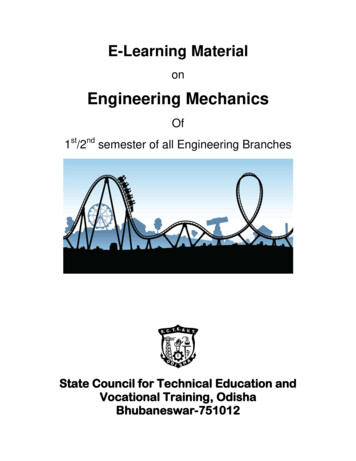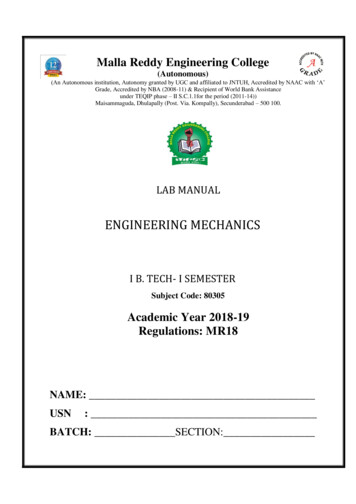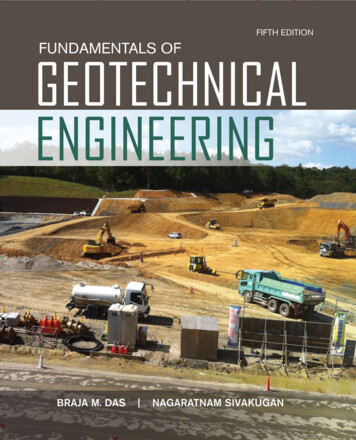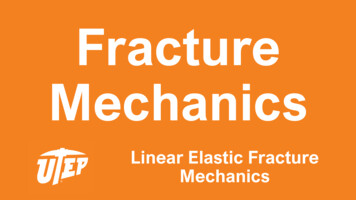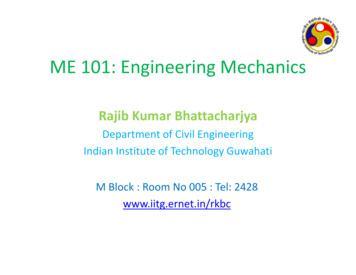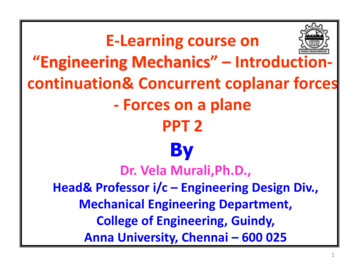
Transcription
Principles ofEngineering MechanicsVolume 2Dynamics - The Analysis of Motion
MATHEMATICAL CONCEPTSAND METHODSIN SCIENCE AND ENGINEERINGSeries Editor: Angelo MieleMechanical Engineering and Mathematical SciencesRice UniversityLatest volumes in this series:PRINCIPLES OF ENGINEERING MECHANICS:VOLUME 2. DYNAMICS-THE ANALYSIS OF MOTION· Millard F. Beatty. ir.CONSTRAINED OPTIMIZATION AND IMAGE SPACE ANALYSIS:VOLUME 1. SEPARATION OF SETS AND OPTIMALITYCONDITIONS Franco GiannessiADVANCED DESIGN PROBLEMS IN AEROSPACE ENGINEERING:VOLUME 1. ADVANCED AEROSPACE SYSTEMS Editors Angelo Mieleand Aida FredianiUNIFIED PLASTICITY FOR ENGINEERING APPLICATIONS· Sol R. BodnerTHEORY AND APPLICATIONS OF PARTIAL DIFFERENTIALEQUATIONS Piero Bassanini and Alan R. ElcratNONLINEAR EFFECTS IN FLUIDS AND SOLIDS Editors MichaelM. Carrolland MichaelA. Hayes
Principles ofEngineering MechanicsVolume 2Dynamics - The Analysis of MotionMillard F. Beatty, Jr.Professor Emeritus, Departm ent of Engineering MechanicsUniversity of Nebraska-Lincoln. Lincoln. NE Springer
Millard F. Beatty, Jr., PhDProfessor Emeritus, Department of Engineerin g Mechanic sUniversity of Nebraska-LincolnLincoln, NE 68588-0526E-mail: mbeatty2 @unl.eduLibrary of Congress Control Number: 20059350 I0ISBN-lO: 0-387-23704-6ISBN-13: 9780387237046Printed on acid-free paper. 2006 Springer Science Bu siness Media, Inc.All rights reserved. This work may not be translated or copied in whole or in part without the writtenpermission of the publisher (Springer Science- Business Media, Inc., 233 Spring Street, New York,NY 10013, USA), except for brief excerpts in connection with reviews or scholarly analysis. Usein connection with any form of information storage and retrieval, electronic adaptation, computersoftware, or by similar or dissimilar methodology now known or hereafter developed is forbidden.The use in this publication of trade names, trademarks, service marks, and simliar terms, even if theyare not identified as such, is not to be taken as an expression of opinion as to whether or not they aresubjec t to proprietary rights.Printed in the United States of America.9 8 7 6 5 4 3 2 Ispringeronline.com
To my wife and best friendNADINE CHUMLEY BEATTY,to our childrenLAURA,ANNandSCOT and to our grandchildrenBOONE, BRITTANY, HUNTER,TANNER and TREVOR
PrefaceThis volume, which begins with Chapter 5, is a vector treatment of the principlesof mechanics written primarily for advanced undergraduate and first year graduatestudents specializing in engineering. A substantial part of the material, however,exclusive of obvious advanced topics, has been tailored to provide a first course forsophomore or junior level undergraduates having two years of university mathematics through differential equations, which may be taken concurrently. The bookalso serves as a sound, self-study review for advanced students specializing inmechanics, engineering science, engineering physics , and applied mathematics. Itis prerequisite, of course, that the reader be familiar with vector and elementarymatrix methods, the primitive concepts of mechanics, and the basic kinematicalequations developed in Volume I, which comprises the first four chapters of thistwo volume series. In addition, it is recommended that advanced students be familiar with the elements of tensor algebra and finite rigid body rotations treatedthere in Chapter 3.The arrangement of the subject into the separate parts kinematics and dynamics has always seemed to me the best didactic approach, and it still does .Unfortunately, the luxury of a slow-paced two semester course on these subjects isseldom afforded . Therefore, in a concentrated, fast-paced single semester course,especially for a diverse group of undergraduates, a level and variety of topics maybe chosen for presentation to address student needs and to satisfy curriculum objectives. But a great deal of the subject matter also can be assigned first to readingand later discussed briefly in lectures . Assigned reading of my discourse on thefoundation principles of classical mechanics, for example, might offer an opportunity for an interesting dialogue among students and the instructor. At the bottomline, however, the classroom usage of this material must be assessed by the teacherin keeping with the class level, the course objectives, the curriculum schedule, andthe desired emphasis.Naturally, the presentation is influenced by my personal interests and background in mechanical engineering, engineering science, and mechanics. Consequently, my approach definitely is somewhat more sophisticated and mathematical than is commonly found in traditional textbooks on engineering mechanics.vii
viiiPrefaceIn keeping with this approach, the prerequisite mathematics, principally that ofthe seventeenth and eighteenth centuries, is used without apology . Nevertheless,aware that many readers may not have mastered these prerequisite materials, Ihave exercised care to reinforce the essential tools both directly within the text andindirectly in the illustrations, exercises and problems selected for study. Elementsof the theory of linear differential equations of the second order, for example,are presented; hyperbolic functions are introduced and illustrated graphically; theanalytic geometry of conic sections is reviewed; and advanced students will find athoughtful discussion on the subject of elliptic functions and integrals applied inseveral examples. These and other topics are illustrated in many physical applications throughout the book; and several exercises and problems expand on relateddetails. Instances where material may be omitted without loss of continuity areclearly indicated.This presentation of dynamics focuses steadily on illustrating the predictivevalue of the methods and principles of mechanics in describing and explaining themotion and physical behavior of particles and rigid bodies under various kinds offorces and torques . The emphasis throughout this book is principally analytical,not computational, though many numerical examples and problems are provided toexpose the relevant aspects of an example or to illustrate certain theoretical details.Examples have been selected for their interest and instructive value and to help thestudent achieve understanding of the various concepts, principles, and analyticalmethods. In some instances, experimental results, factual situations, and applications that confirm analytical predictions are described. I hope the historical remarksand several relevant short stories add interest and reality to the subject. Numerousassignment problems, ranging from easy, straightforward extensions or reinforcements of the subject matter to more difficult problems that challenge the creativeskills of better students, are provided at the end of each chapter. To assist the student's study of dynamics, answers to the odd-numbered problems are provided atthe back of the book.It is axiomatic that physical intuition or insight cannot be taught. On the otherhand , competence in mathematical and physical reasoning may be developed sothat these special human qualities may be intelligently cultivated through study ofphysical applications that mirror the world around us and through practice of therational process of reasoning from first principles. With these attributes in mind,one objective of this volume is to help the engineering student develop confidence in transforming problems into appropriate mathematical language that maybe manipulated to derive substantive and useful physical conclusions or specificnumerical results. I intend that this treatment should present a penetrating andinteresting treatise on the elements of classical mechanics and their applicationsto engineering problems; therefore, this text is designed to deepen and broadenthe student's understanding and to develop his or her mastery of the fundamentals .However, to reap a harvest from the seeds sown here, it is important that the studentwork through many of the examples and problems provided for study. When teaching this course over the years, I have usually assigned six problems per week, two
Prefaceixper class period , roughly ninety per semester. If the assignment problems chosenrange from easy to difficult, I don't think it is wise to assign more . The mere understanding that one may apply theoretical concepts and formula s to solve a particularproblem is not equivalent to possession of the knowledge and skills required toproduce its solution . These talents grow only from experience in dealing repeatedly with these matters . My view of the importance of solving many problems isexpressed further at the beginning of the problem set for Chapter 5, the first chapterof this volume. The attitude emphasi zed there is echoed throughout this text. It ismy hope that these books on kinematics and dynamic s may provide engineeringstudents and others with solid mathematical and mechanical foundation s for future advanced study of topics in mechanical design analysis, advanced kinematic sof mechani sms and analytical dynamic s, mechanical vibrations and control s, andareas of continuum mechanic s of solids and fluids.The Contents of This VolumeVolume 2: Dynamics, concern s the analysi s of motion based on classicalfoundation princip les of mechanic s due to Newton and Euler, later cast in a generalized energy based formulation by Lagrange. A fresh development of a classicalsubject like this is seldom seen. I believe, however, that the reader will find withinthese pages many fresh developments, beginning with my discussion of the fundamental classical princip les of mechanic s and concluding with the presentationof the elegant analytical formulation of the Lagrange equations of motion . And inbetween, the reader will find here a refreshingly different, consistent , logical, andgradual development and careful application of all of the classical principles ofmechanic s for a particle , a system of particle s, a rigid body, actually any number ofparticle s and rigid bodies, subjected to various kinds of forces and torques. Someunusual, hopefully interesting thing s to look for are sketched below.Chapter 5: The Foundation Principle s of Classical Mechanic s, presents adetailed study and fresh discussion of Newton 's laws of motion, Newton 's theoryof gravitation , the role of inertial reference frame s, and Newton 's second law ofmotion relativeto the moving Earth frame . Further, two fascinating applicationsof Coulomb's laws of friction having engineering significance are presented. Thechapter conclu des with an advanced topic borrowed from continuum mechanics ,here applied to deduce the general law of mutual interaction between two particles .This interesting topic has not previously appeared in any textbook.The kinematical equations characterizing the velocity and acceleration of aparticle in terms of rectangular, intrinsic, cylindrical, and spherical coordinates areapplied in Chapter 6: Dynamics of a Particle , in the formulation of the equationsof motion in a variety of special applications. Besides gravitational and frictionalforces, additional electromagnetic, elastic spring, and drag force laws are introduced and illustrated in some atypical examples that include the mechanics of
xPrefacean ink jet printer and Millikan 's famous oil drop experiment. Of course, familiarelementary problems, sometimes having a novel twist, appear here as well. Theelements of projectile motion with examples that include drag force effects andthe fanciful exploits of Percy Panther and Arnold Aardvark surely will attract attention. Several additional distinctive examples include a nonlinear oscillator, thefinite nonlinear radial oscillation of a particle of an incompressible rubber tube,and problems of motion relative to the moving Earth frame that include Reich'sexperiment on the deflection of falling pellets and Foucault's experiment demonstrating the rotation of the Earth . The projectile deflection problem is solved ; and,with this in mind, the historic tragic battle of the Falkland Islands is described.The first integral principles of mechanics for a particle-impulse-momentum,torque-impulse, work-energy , and the conservation laws of momentum, momentof momentum, and energy-are developed in Chapter 7: Momentum, Work, andEnergy. Along with several typical applications, some advanced topics treated thereinclude an introduction to elliptic functions and integrals in the problem of thefinite amplitude oscillations of a pendulum. The isochronous cycloidal pendulumand Huygens's clock, and orbital motion and Kepler's laws, are other interestingexamples.The classical principles of mechanics and first integrals for a particle areextended to study in Chapter 8: Dynamics of a System of Particles. The importanceof the center of mass of the system, first mentioned in Chapter 5, is now evident.The two body problem correcting Kepler's third law is a distinctive illustration.In preparation for later work on rigid bodies, the moment of momentum principlewith respect to a moving reference point, first derived in Chapter 6 for a particle,and the reduction to its simplest form, is carefully described . Several examples ofsimple systems of particles are demonstrated.The elements of tensor algebra, including the Cartesian tensor transformationlaw, introduced in Volume 1, Chapter 3, are exploited in Chapter 9: The Momentof Inertia Tensor. Here the inertia tensor and its general properties are studied andapplied to complex structured (composite) bodies . The center of mass concept fora simple rigid body, first studied in Chapter 5, is extended to composite bodies aswell. The tensorial form of the parallel axis theorem is proved, and its interpretationis illustrated in examples. The principal (extremal) values of the inertia tensor andtheir directions are derived by the method of Lagrange multipliers; and their easygeometrical interpretation in terms of Cauchy's momental ellipsoid is described.These topics playa key role in the general theory of rigid body motion . Someadvanced analytical topics on the principal values of general symmetric tensors andthe multiplicity of principal values and corresponding principal axes are exploredat the end.Chapter 10: Dynamics of a Rigid Body, the most difficult of the subjectstreated in this book, focuses on Euler's generalization of Newton's principles ofmechanics, now extended to characterize the equations of motion for all bodiessolids, fluids, gasses-but herein restricted principally to the motions of rigid solidbodies. Euler's laws are set down separately and discussed in detail, somewhat
Prefacexiparallel to my earlier discussion of Newton's principles; but there are sharp differences . First, the principle of determinism includes both forces and torques, andthe third law of mutual interaction of both forces and torques follows as a theoremfrom Euler's first and second laws. The remaining developments, however, arefairly standard leading to Euler's nonlinear vector differential equation of motionfor a rigid body in terms of its moment of inertia tensor. The key role of the principal body axes in the simplification of Euler's scalar equations is demonstrated. Theusual general first integral principles on impulse-momentum, torque-impulse, conservation of momentum and moment of momentum, the work-energy and energyconservation principles for a rigid body are obtained. It is worth noting, however,that two forms of Euler's second law of motion with respect to a moving referencepoint, seldom discussed in other works, are derived. Their reduction to the simplestcommon case is thoroughly discussed, and several typical sorts of applications arestudied. Some advanced examples describe the effect of the Earth 's rotation incontrolling the motion of a gyrocompass, the stability of the torque-free rotationof a spinning rigid body, the sliding, slipping and rolling motion of a billiard ball,and the motion of a general rigid lineal body in a Stokes medium.A careful, thorough introduction to Lagrange's equations of motion for holonomic dynamical systems is provided in Chapter II : Introduction to AdvancedDynamics. The general form of Lagrange 's equations, an energy based formulation of the equations of motion, is first motivated in their derivation for aholonomic system consisting of a single particle. The principle of virtual work relates the generalized forces in these equations to the physical forces that act on theparticle. The work-energy principle, Lagrange's equations for conservative scleronomic systems, and their first integral principle of conservation of energy follow.Precisely all of the same equations are shown to hold for any system of discrete material points having any number of degrees of freedom. For conservative systems,recognition of so-called ignorable coordinates in the Lagrangian energy functionleads immediately to easy first integrals of Lagrange's equations. Generalized momenta are introduced and Lagrange's equations for each generalized coordinateare recast in a form having the appearance of Newton 's second law in which theLagrange forces consist of the generalized forces and certain pseudoforces of thesort encountered differently in earlier studies. Generalized first integral principlesof conservation of momenta and the generalized impulse-momentum principlefollow. All of the results are illustrated in several examples together with the physical interpretation of the terms . Lagrange 's equations for both conservative andnonconservative general dynamical systems are then deduced from Hamilton 'svariational principle of least action . As a consequence, Lagrange's equations areimmediately applicable to study the motion of rigid bodies ; in fact, any dynamicalsystem consisting of any number of particles and rigid bodies. It is only necessaryto define the Lagrangian energy function, however complex, and to identify thecorresponding generalized forces. Accordingly, the Lagrange equations are applied to formulate the equations of motion for several such physical systems . Thetheory of small vibrations for nondegenerate, multidegree of freedom systems is
xiiPrefacederived and demon strated in an example. Finally, Lagrange's equations are modified to account for the effect of Stokes type damping in a general formulation of theRayleigh dissipation function, and the result is illustrated in some concluding examples that include an application to the theory of small vibrations with damping .Thi s relatively brief introducti on to advanced dynamics presents the reader withtools adequate to pursue more advanced, abstract studies of analytical dynamics.In every chapter throughout this work the reader will find a great many historical remark s, annotation s, and references on the several topics treated here. Ihope these little stories, digressions, and annotation s will add life and bring tothe subject a reality not seen in most books of this kind. Countle ss examples andproblems are provided as aids to understanding and visualizing the details of thetheory; and, in most instance s, a physical interpretation is presented or perhapssome unusual effect is identified. This sort of discovery and prediction derivedfrom the principles of mechanics and leading to results that most often are not intuitively evident, drive the purpo se of the analysis . It is important that the studentcultivate the habit of attempting to interpret the physical phenom ena or unusualeffects that emerge from problem analysi s. Ample opportunity for the reader to doso is provided within the problem s provided at the end of each chapter. So far as Iam aware, the treatment of problem s provided herein usually is quite different andmore thorough than found in other comparable sources known to me. Nevertheles s,by consulting the listed references or their own favorite books, both the teacherand the student should be able to supplement the many examples and problem s tomeet their special needs.In writing this book, I have appealed over many years to numerou s sources.While I do not necessarily subscribe to their approach to mechanics, several ofthe references on classical and engineering mechanic s that I found particularlyhelpful are cited at the end of each chapter, usually with annotations to describethe substance of the work and to identify specific topics that may be consulted forcollateral study. The presentation has also benefited greatly from the very manyhistorical papers and books referenced there . I hope the acknowledgments arecomplete. It is impossible, of course, to be precise in citing my specific use ofevery source, and I apologize if I may have overlooked or forgotten a particularreference.Acknowledgmentlowe much to Mr. Joe Haas at the University of Kentucky during the 1980s,for his good humor, untiring patienc e, and painstaking care in the tediou s task ofadding typeset lettering to my numerou s ink drawing s. I came to appreciate thiseven more when years later I did this myself. I am also grateful to Ms. MarjorieBisbee and Mr. James Pester at the University of Nebraska-Lincoln in the 1990s,and I thank Mr. Haas as well, for applying their artistic talents and computer skills
Prefacexiiito draw from my pencil sketches some of the illustrations that appear here. I hopethey are not offended by my modifications and addition of shading to all of theillustrations.The students that took my courses in dynamics at the University of Delaware,the University of Kentucky, and the University of Nebraska-Lincoln deserve myspecial thanks for the opportunity to learn from them as well. It was especiallyexciting to find in grading some assignment papers, an essential but usually dulland tiresome task, that from time to time a student would discover an interestingsolution method that I had not thought of. In this regard, I thank my former graduatestudent at Nebraska, Professor Alex Elfas-Ziifiiga at the Instituto Technol6gicoy de Estudios Superiores de Monterrey, Mexico; he read an early draft of themanuscript in the 1990s and worked through countless problems in confirmationof my solutions. As a consequence of such student efforts over many years, forwhich I am most grateful, virtually all of the problems in this book have been testedand their solutions confirmed . Any errors that may yet appear in the answers at theback of this volume are mine .The joy of work with graduate students in areas of finite elasticity, relatedfunded research interests, and classroom, profess ional, and administrative obligations as Chairman of the Department of Engineering Mechanics at Nebraska,constantly took precedence over my efforts to complete this volume started so longago. When at last the manuscript was finished in the spring of 2004, I sought thecriticism and comment of several respected colleagues who kindly accepted theburden to read all or a portion of the manuscript. Their thoughtful and constructivecritiques led to many improvements that served to enhance the quality of the book .I am grateful for their input and for their unsolicited supportive complimentarycomments. Such errors as may remain, however, are my sole responsibility. Itis a pleasure to thank Professor Eveline Baesu, University of Nebraska-Lincoln,and Professor David Steigmann, University of California, Berkeley; they providedhelpful remark s and useful suggestions on various parts of the manuscript. I amindebted to Professor Emeritus Oscar W. Dillon, University of Kentucky; his constructive critical comments, helpful discussions, and thoughtful recomm endationsand remarks covering a great many aspects of the manuscript have been invaluable .Finally, I am indeed most grateful to Professor Emeritus Michael A. Hayes, University College, Dublin, for his thoughtful, painstaking review of both the manuscriptand the proof; he exposed in both a great many typographical slips and providednumerous beneficial suggestions and invaluable comments from which the finalversion of this book has greatly benefited throughout.Millard F. Beatty, Jr.Lexington, Kentucky
ContentsNote to the reader: This book, which begins with Chapter 5, is the second of a series of twovolumes on the Principles of Engineering Mechanics. Chapters 1 through 4 and Appendices Aand B appear in Volume J: Kinematics-The Geometry of Motion, which includes the Answersto Selected Problems for that volume and a separate Index on its contents. Volume 2 includesChapters 5 through 11, AppendicesC and D, Answers to Selected Problems for this volume, anda separate Index on its contents.5. The Foundation Principles of Classical Mechanics5.1. Introduction5.2. Mass, Momentum, and the Center of Mass5.2.1. Mass and Momentum of a Particle5.2.2. Mass, Momentum, and Center of Mass of a System of Particles . . . . . . . .5.2.3. Mass, Momentum, and Center of Mass of a Rigid Body . . . . . .5.3. Moment of a Vector About a Point. . . . . . . . . . . . . . . . . . . . . . . . . . . . . . . . . . . . . .5.3.1. Reference Point Transformation Rule5.3.2. Moment of a Force About a Point5.3.3. Equipollent Force Systems . . . . . . . . . . . . . . . . . . . . .5.4. Moment of Momentum . . . . . . . . . . . . . . . . . . . . . . . . . . . . . . . . . . . . . . . . . . . . . . . . . .5.4.1. Moment of Momentum of a Particle .5.4.2. Moment of Momentum of a System of Particles. . . . . . . . . . . . . . . .5.4.3. Moment of Momentum of a Body5.5. Newton's Laws of Motion . . . . . . . . . . . . . . . . . . . . . . . . . . . . . . . . . . . . . . . . . . . . . . . . . . . . . .5.5.1. The Material Universe and Forces. . . . . . . . . . . . . . . . . . . . . . . . . . . . . . . . . . .5.5.2. The First Law of Motion. . . . . . . . . . . . . . . . . . . . . . . . . . .5.5.3. The Second Law of Motion . . . . . . . . . . . . . . . . . . . . . . . . . . . . . . . . . . . . . . . . . . .5.5.4. The Law of Mutual Action5.6. Newton's Law of Gravitation5.6.1. The Gravitational Field of a Particle . . . . . . . . . . . . . . . . . . . . . . . . . .5.6.2. The Gravitational Field of a System of Particles5.6.3. The Gravitational Field of a Body5.7. Some Applications of Newton's Theory of Gravitation . . . . . . . . . . .xv356610151616182021212224252627303134353638
xviContents5.8. Gravitational Attraction by an Ideal Planet. . . . . . . . . . . . . . . . . . .5.9. Gravitational Force on an Object Near an Ideal Planet . . . . . . . . . . . . . . . . . . . . . . .5.10. Weight of a Body and its Center of Gravity5.10.1. The Local Acceleration of Gravity-An Estimate5.10.2. Center of Gravity of a Body5.11. Coulomb 's Laws of Friction5.1 I.l . Contact Force between Bodies5.1 1.2. Governing Principles of Sliding Friction5.1 1.3. Equilibrium of a Block on an Inclined Plane5.11.4 . Motion of a Block on an Inclined Plane. . . . . . . . . . . . . . . . . . . . . . . .5.12. Applications of Coulomb 's Laws5.12.1. The Sliding Can Experiment5.12.2. DamntheTorpedoes!5.13. What is the Inertial Frame?5.14. The Second Law of Motion in a Noninertial Frame5.15. Newton' s Law in the Noninertial Earth Frame5.16. The Apparent Gravitational Field Strength of the Earth5.17. Newton 's Law in the Earth Frame5.18. Frame Indifference and the Law of Mutual Internal Action5.18.1. Change of Reference Frame5.18.2. The Principle of Material Frame Indifference5.18.3. The Law of Mutual Internal ActionReferencesAppend ix: Measure Units in MechanicsProblems6. Dynamics of a Particle6.1. Introduction6.2. Component Forms of the Newton-Euler Law6.3. Some Introductory Examples and Additional Concepts . . . . . . . . . . . . . . . . . . . . .6.3.1. Some Applications in a Rectangular Cartesian ReferenceFrame6.3.2. Intrinsic Equation of Motion for a Relativistic Particle6.3.3. Electric and Magnetic Forces on a Charged Particle . . . . . . . . .6.3.4. Fun at the Amusement Park . . . . . . . . . . . . . . . . . . . . . . . . . . . . . . .6.3.5. Formulation of the Particle Dynamics Problem6.4. Analysis of Motion for Time Dependent and Constant Forces6.4.1. Motion under a Time Varying Force6.4.2. Motion under a Constant Force6.5. Motion under Velocity Dependent Force6.5.1. Stokes's Law of Resistance . .6.5.2. Formulation of the Resistance Problem6.6. An Important Differential Equation6.6.1. General Solution of the Homogeneous 26
Contents6.6.2. Particular Solution of the General Equation6.6.3. Summary of the General Solution6.6.4. Physical Character of the Solution . . . . . . . . . . . . . . . . . . . . . . . . . . . . .6.7. The Simple Harmonic Oscillator6.7.1. Hooke's Law of Linear Elasticity. . . . . . . .6.7.2. The Linear Spring-Mass System6.7.3. The Simple Pendulum6.7.4. The Common Mathematical Model in Review . . . . . . . .6.8. Motion of a Charged Particle in an Electromagnetic Field . . . . . . . . . . . . . . . . . .6.9. Motion of a Slider Block in a Rotating Reference Frame . . . . . . . . . .6.9.1. Uncontrolled Motion of a Slider Block6.9.2. Controlled Motion and Instability of a Slider Block. . . . . . . . . . . .6.10. The Moment of Momentum Principle6.10.1. Application to the Simple Pendulum Problem6.10.2. The Moment of Momentum Principle for a Moving Point6.11. Free Vibrations with Viscous Damping6.11. I. The Equation of Motion for Damped, Free Vibrations6.11.2. Analysis of the Damped, Free Vibrational Motion6.11.3. Summary of Solutions for the Damped, Free Vibrational Motion .6.12. Steady, Forced Vibrations with and without Damping6.12.1. Undamped Forced Vibrational Motion6.12.2. Steady-State Vibrational Response of a Damped System6.12.3. Force Transmissi
mechanics, engineering science, engineering physics, and applied mathematics. It is prerequisite, of course, that the reader be familiar with vector and elementary matrix methods, the primitive concepts of mechanics, and the basic kinematical equations developed in Volume I, which comprises the first four chapters of this two volume series.

